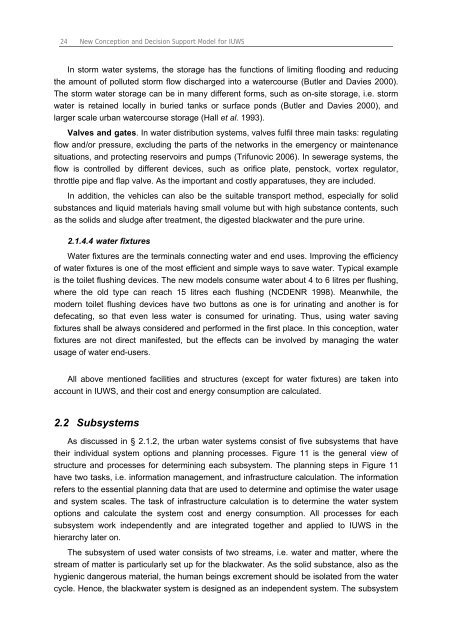Chapter 3 Decision Support Model (IUWS-DSM) - Tubdok
Chapter 3 Decision Support Model (IUWS-DSM) - Tubdok
Chapter 3 Decision Support Model (IUWS-DSM) - Tubdok
Create successful ePaper yourself
Turn your PDF publications into a flip-book with our unique Google optimized e-Paper software.
24 New Conception and <strong>Decision</strong> <strong>Support</strong> <strong>Model</strong> for <strong>IUWS</strong><br />
In storm water systems, the storage has the functions of limiting flooding and reducing<br />
the amount of polluted storm flow discharged into a watercourse (Butler and Davies 2000).<br />
The storm water storage can be in many different forms, such as on-site storage, i.e. storm<br />
water is retained locally in buried tanks or surface ponds (Butler and Davies 2000), and<br />
larger scale urban watercourse storage (Hall et al. 1993).<br />
Valves and gates. In water distribution systems, valves fulfil three main tasks: regulating<br />
flow and/or pressure, excluding the parts of the networks in the emergency or maintenance<br />
situations, and protecting reservoirs and pumps (Trifunovic 2006). In sewerage systems, the<br />
flow is controlled by different devices, such as orifice plate, penstock, vortex regulator,<br />
throttle pipe and flap valve. As the important and costly apparatuses, they are included.<br />
In addition, the vehicles can also be the suitable transport method, especially for solid<br />
substances and liquid materials having small volume but with high substance contents, such<br />
as the solids and sludge after treatment, the digested blackwater and the pure urine.<br />
2.1.4.4 water fixtures<br />
Water fixtures are the terminals connecting water and end uses. Improving the efficiency<br />
of water fixtures is one of the most efficient and simple ways to save water. Typical example<br />
is the toilet flushing devices. The new models consume water about 4 to 6 litres per flushing,<br />
where the old type can reach 15 litres each flushing (NCDENR 1998). Meanwhile, the<br />
modern toilet flushing devices have two buttons as one is for urinating and another is for<br />
defecating, so that even less water is consumed for urinating. Thus, using water saving<br />
fixtures shall be always considered and performed in the first place. In this conception, water<br />
fixtures are not direct manifested, but the effects can be involved by managing the water<br />
usage of water end-users.<br />
All above mentioned facilities and structures (except for water fixtures) are taken into<br />
account in <strong>IUWS</strong>, and their cost and energy consumption are calculated.<br />
2.2 Subsystems<br />
As discussed in § 2.1.2, the urban water systems consist of five subsystems that have<br />
their individual system options and planning processes. Figure 11 is the general view of<br />
structure and processes for determining each subsystem. The planning steps in Figure 11<br />
have two tasks, i.e. information management, and infrastructure calculation. The information<br />
refers to the essential planning data that are used to determine and optimise the water usage<br />
and system scales. The task of infrastructure calculation is to determine the water system<br />
options and calculate the system cost and energy consumption. All processes for each<br />
subsystem work independently and are integrated together and applied to <strong>IUWS</strong> in the<br />
hierarchy later on.<br />
The subsystem of used water consists of two streams, i.e. water and matter, where the<br />
stream of matter is particularly set up for the blackwater. As the solid substance, also as the<br />
hygienic dangerous material, the human beings excrement should be isolated from the water<br />
cycle. Hence, the blackwater system is designed as an independent system. The subsystem

















